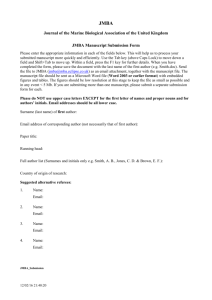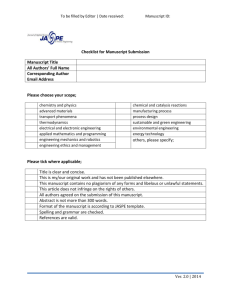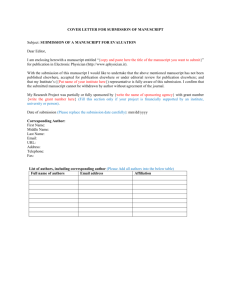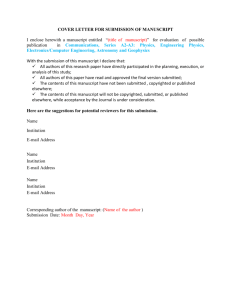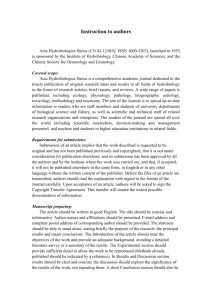How to format a submission for with the journal’s own L TEX2e-style A
advertisement
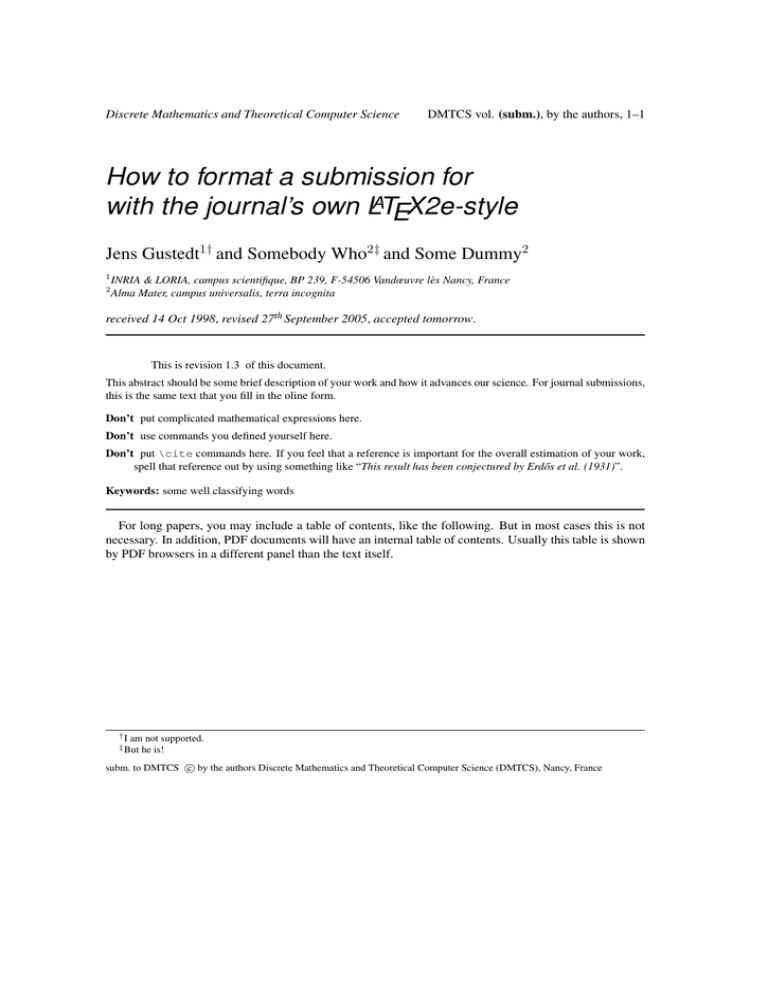
Discrete Mathematics and Theoretical Computer Science
DMTCS vol. (subm.), by the authors, 1–1
How to format a submission for
with the journal’s own LATEX2e-style
Jens Gustedt1† and Somebody Who2‡ and Some Dummy2
1
2
INRIA & LORIA, campus scientifique, BP 239, F-54506 Vandœuvre lès Nancy, France
Alma Mater, campus universalis, terra incognita
received 14 Oct 1998, revised 27th September 2005, accepted tomorrow.
This is revision 1.3 of this document.
This abstract should be some brief description of your work and how it advances our science. For journal submissions,
this is the same text that you fill in the oline form.
Don’t put complicated mathematical expressions here.
Don’t use commands you defined yourself here.
Don’t put \cite commands here. If you feel that a reference is important for the overall estimation of your work,
spell that reference out by using something like “This result has been conjectured by Erdős et al. (1931)”.
Keywords: some well classifying words
For long papers, you may include a table of contents, like the following. But in most cases this is not
necessary. In addition, PDF documents will have an internal table of contents. Usually this table is shown
by PDF browsers in a different panel than the text itself.
†I
am not supported.
he is!
‡ But
c by the authors Discrete Mathematics and Theoretical Computer Science (DMTCS), Nancy, France
subm. to DMTCS 2
Jens Gustedt and Somebody Who and Some Dummy
Contents
1
Introduction
2
2
Providing Information for the first Page
3
3
Hints for the manuscript itself
3.1 Numbering commands . . . .
3.2 Markup commands . . . . . .
3.3 Headings . . . . . . . . . . .
3.4 Proper Names . . . . . . . . .
3.5 Use a Spell Checker . . . . . .
3.6 Mathematics . . . . . . . . . .
3.7 Cross-references and citations
.
.
.
.
.
.
.
.
.
.
.
.
.
.
.
.
.
.
.
.
.
.
.
.
.
.
.
.
.
.
.
.
.
.
.
.
.
.
.
.
.
.
.
.
.
.
.
.
.
.
.
.
.
.
.
.
.
.
.
.
.
.
.
.
.
.
.
.
.
.
.
.
.
.
.
.
.
.
.
.
.
.
.
.
.
.
.
.
.
.
.
.
.
.
.
.
.
.
.
.
.
.
.
.
.
.
.
.
.
.
.
.
.
.
.
.
.
.
.
.
.
.
.
.
.
.
.
.
.
.
.
.
.
.
.
.
.
.
.
.
.
.
.
.
.
.
.
.
.
.
.
.
.
.
.
.
.
.
.
.
.
.
.
.
.
.
.
.
.
.
.
.
.
.
.
.
.
.
.
.
.
.
.
.
.
.
.
.
.
.
.
.
.
.
.
.
.
.
.
.
.
.
.
.
.
.
.
.
.
.
.
.
.
.
.
.
.
4
5
5
5
5
5
6
6
4
PDF Files
7
5
Graphics
7
6
Summary of Options
8
7
Summary of Relevant Commands
8
8
Summary of Relevant Environments
9
1
Introduction
The LATEX2e-style for DMTCS is derived straight forward from the usual article.sty. Its main
purpose is to ensure a common layout policy of all articles in DMTCS and to provide editors, referees and
readers with the necessary information. If you think you need an introduction to LATEX2e or search for
pointers to other literature on that, you should consider reference Oetiker et al. (1999) given at the end.
Before you read on to know how to use our style file please ensure that the manuscript fits well into
DMTCS.
1. DMTCS covers Discrete Mathematics and Theoretical Computer Science as domain of interest.
2. DMTCS is a scientific journal. This requires that your work is
original The main results of your paper must not have appeared elsewhere in a journal, neither by
yourself nor by somebody else.
There is no excuse for plagiarism, not even self-plagiarism. We have a good record in tracking
such things down, be warned.
important Your results must be of importance to a wider public and should be of interest for more
readers than just the referees.
Formatting a submission for DMTCS
3
self contained Other than for conference proceedings, we don’t have any restrictions on the number of pages for an article. So there is no excuse to suppress proofs or not to give verbose
examples. On the other hand, self containing short notes are highly welcome.
complete Your work must relate to the current state of the art of the domain in question. In particular, foreign and own results external to the manuscript must be correctly credited and complete
reference to such related work must be given.
legible The journal’s language is English, all conventions for scientific work in that language apply.
correct Your work must be mathematical correct and its quality of writing must be such that the
referees will agree upon this fact.
Your writing must be grammatically correct. Be ensured, that especially authors that are nonnative speakers of English will receive all possible help to correct flaws. But also have in mind,
that incorrect grammar might be the cause of severe misunderstandings and finally result in a
rejection of the paper.
3. DMTCS is
no circular letter, and
no preprint server.
If you are looking for that, please consider the wide possibilities that the web offers nowadays.
2
Providing Information for the first Page
First of all, for a correct submission we need some basic information. Consider this file here itself as an
example how this should be done. We need the following type of information:
• The name(s) of the author(s), provided by the \author command.
This is about the same as for standard LATEX2e. Please refer to your LATEX book to see how this is
usually done, or look at the examples given here in this file.
There is some speciality, though, for sets of authors with different affiliations. In that case, put an
appropriate \addressmark{i} directly after the last name of an author, where i corresponds to
affiliation number i. See below, on how to include several affiliations into the address command.
• The title of the manuscript, provided by the \title command.
The title command may be given in two different forms. The first is
\title{Your title goes here}
If done like that, the title that you give is used as running head for the odd numbered pages as well.
If your title is too long such that it doesn’t fit into the running head you should use the alternative
form
\title[Formatting a submission for DMTCS]{How to format a submission
for DMTCS with the journal’s own \LaTeX2e-style}
4
Jens Gustedt and Somebody Who and Some Dummy
Here the string that inside the [ ] is used in the running head.
• The address(es) of the authors, provided by the \address command.
If different authors have different affiliatiions, put each such address on a line of its own, separate
the lines by a \\ command, and start line number i with the command \addressmark{i}. For
an example, look at the LATEX-source of this file here.
• The revision n0 of the manuscript, provided by the \revision command.
This is to distinguish different versions of your manuscript during the refereeing process. The use
of the command is as simple as in
\revision{1}
• Some keywords that classify your work, provided by the \keywords command. Be careful on the
choice of these keywords, you are the author, you should know best what is adequate such that your
article can be easily and correctly identified by search engines and alike. Give it in the form
\keywords{first item, second, third}
So each “key word” might consist of several words in the usual sense. To separate several key words
use commas.
These keywords must be the same as the ones that are given when you fill out the http-form for
submission.
• An abstract of you manuscript, provided by the abstract environment. This should be no longer
than a paragraph and concisely reflect the main contributions of your work.
Many readers (such as editors) base their selection whether to look at a paper more closely on that
abstract. In particular there are high chances that the decision which referees are assigned to your
manuscript is mainly based on that abstract. You have been warned.
This abstract must be the same as the one that is given when you fill out the http-form for submission.
3
Hints for the manuscript itself
I suppose in the following that you write a paper since you want to publish it, i.e., make it publically
available, and that you want it to be read and understood. Therefore it is imperative that you stay inside
the established conventions for mathematical or TCS texts. People are used to these conventions. They
help them to easily and quickly access the real contents of your text and to not to be diverted by its
appearance.
Formatting a submission for DMTCS
3.1
5
Numbering commands
Please use the standard conventions for all commands and environments that provide a numbering such as
theoremlike environments or sections. In particular usual counting starts at 1 and not at 0. In particular,
we think that an introduction is an integral part of a paper and should be counted as one (= 1!).
Never ever number items, paragraphs, equations, cases theorems or whatsoever manually. This is
the age of computers, use them before they use you. We need automatically produced numbers to put
hyperlinks into your text, such that reading a paper in DMTCS becomes a real ‘electronic’ experience.
3.2
Markup commands
Don’t use markup of text according to some layout or style, but to stress semantical differences. The
correct way to emphazise a certain part of your text is \emph{emphazise}. Don’t use the \text..
family for that purpose, in particular don’t use \textit or \it. They have different meanings and
rendering. E.g., observe the word different in the previous phrase: this is rendered in an upright font since
this is an \emph inside another \emph. On the other hand \texit for the abreviations “e.g.” and “i.e.”
is appropriate. This is because they are Latin (for exempli gratia and id est), and all foreign text inside
English text has to be put in italics (sic!).
If ever you use commands that change the font use the modern form \text.. for them, such as
\textbf{text}, \textit{text} or \textsc{text}. These commands know better what has
to be done when they switch back to normal than the ancient commands {\bf text}, {\it text\/}
or {\sc text}.
3.3
Headings
Use the standard heading and structuring commands \section, \subsection etc. to structure your
document. For theorems use the corresponding environments that you may define by means of the
\newtheorem command.
3.4
Proper Names
Names of theorems and alike are considered as proper names. In English (sic!) proper names are capitalized. So please write something like “In Section 2 we have seen...” and “By the Main Theorem we
know...”. But distinguish properly from the use of the word “theorem” as ordinary noun as it is for example
in “In the following theorem we prove ...”.
Please also be careful in the writing of personal names. Customs in different countries are different! Be
sure to use a standard transcription of names that use a different alphabet than English, and also be sure
to use the full capabilities of LATEX2e for accentuated character sets that are based on the Latin alphabet.
Be sure to catch the correct concept of “last name” in that language.
3.5
Use a Spell Checker
It is considered as being very impolite to leave obvious spelling errors in the manuscript before sending it
out. Computers are made for these, use them.
You might either use the North American variant for spelling or the British one, but please don’t mix
them in one paper. The same holds for different possible spellings for the same word as for example
“acknowledg(e)ment” or “formulae” versus “formulas”. Be coherent.
6
Jens Gustedt and Somebody Who and Some Dummy
3.6
Mathematics
Running text must always constitute correct English phrases. An English phrase needs a verb and an
‘=’-sign can not be a replacement for it.
All complicated mathematical formulae should be given on separate lines and should not be spread out
into the running text. Never use the $ form of the math enviroment for these. Human or automatic taggers
have a hard time to recognize which is an opening or a closing $. Use
\begin{math}...\end{math}
for all formulas that spread over several words and
\begin{displaymath}...\end{displaymath}
(or equation etc.) that should be rendered on a line of their own. Using the old fashioned double-dollar
environment
$$ some complicated formula $$
is frowned upon.
You should use LATEX2e environments that provide a numbering for all formulae that are rendered on
line of the their own. Use environmenst such as equation or eqnarray. Such numbers ease the
referee process very much, and after eventual publication easily allow readers to refer to in their own
work.
The quantifiers “∃” and “∀” don’t stand as abbreviations of the partial phrases “there is” and “for all”.
They are reserved for logical formulae as such, that is for work that talks itself of logical formulae as a
subject.
The equal sign “=” has different meanings in parts of the two communities that DMTCS addresses.
1. It might stand for mathematical identity that is discovered a posteriori. As an example take the
following phrase:
An easy computation shows that 4! = 24.
2. It might stand for a definition, as in
For convenience, set 0! = 1.
For the later use of “=” Computer Scientist often tend to use “:=”. Referees should be tolerant to these
different customs.
3.7
Cross-references and citations
Use cross-references throughout your whole paper. Use \label and \ref for that and don’t do the work
of the computer by yourself. Not only that it is easier (believe me!) but also it helps to insert hyperlinks
across the final document in the pdf version, see Section 4.
The same holds for citations. Never ever number citations by hand. This only can go wrong and it will.
Use LATEX’ \cite command. Again, in the pdf version this will have the advantage of a hyperlink that
lets you jump directly to the bibliography item.
7
Formatting a submission for DMTCS
Use bibtex to produce your bibliography. With a little bit of initial overhead it lets you easily maintain
your references. This pays off when you will write more than one article in your life... Have a look into
Oetiker et al. (1999) and to the .bib-file of DMTCS to see how this works.
I personally prefer the so-called natural citation style as it is used herein (via natbib). It has the
advatage that the author names of the work that is cited appear properly. Papers are to the merits of
people. In addition, such a citation by name has the advantage of being easily recognizable without
looking in the bibliography.
4
PDF Files
The style now supports an option pdftex to use in combination with pdflatex. This is now relatively
stable. If you are viewing this document in its pdf form you may see some of the advantages this has: in
particular pdf documents produced in that way have included hyperlinks. If you want to know more about
these features please refer to http://xxx.lanl.gov/hypertex/.
If your installation doesn’t support the package hyperref, you should switch of these features by giving the option nohyperref in the \documentclass declaration at the beginning of your manuscript.
To give you the possibility to include hyperlinks even if your local installation doesn’t support this, we
provide the command \href{URL}{text} in any case.
Fig. 1: The logo of DMTCS.
5
Graphics
Please use the (standard) packages graphics or graphicx to include graphical data and not epsf or
similar. Something like the PostScript picture in the title of this document can be produced as simple as
this \includegraphics[width=0.13\textwidth]{dmtcs}. Note that in this command the
width is given in relation to the width of the text and not in an absolut measure and that the file name is
given without extension. Don’t include the extension of the graphic file in the command! If accepted, we
will have to process your file for PostScript and PDF. Please, leave the choice of the desired format to the
graphicx package.
For a realistic graphic of your paper you should chose a figure environment as is done with the
following for Figure 1
\begin{figure}[htbp]
\begin{center}
\includegraphics{dmtcs}
\caption{The logo of DMTCS.}
\label{fig:logo}
\end{center}
\end{figure}
8
Jens Gustedt and Somebody Who and Some Dummy
If you have several (small) figures that are related to each other you may place them inside one figure
environment. As you may see in Figure 2 how this may look like and consider the source of this description
here on how to refer to each part (that is Figure 2(a) and 2(b)) individually.
(a) height of 1 cm
(b) width of 3 cm
Fig. 2: The scaled logo of DMTCS.
6
Summary of Options
option
submission
final
pdftex
nohyperref
notimes
7
description
whether or not this is considered as a
submission or being the final document
to be enabled when processing with pdflatex
switch reference to hyperref off
switch selection of the times package off
Summary of Relevant Commands
command
\address
\addressmark
\revision
\keywords
\qed
\acknowledgements
\naturals
\integers
\rationals
\reals
\complexes
\primes
description
the affiliation and address of the authors
to number different affiliations for different authors
the revision number, defaults to 1 if this command is omitted
a comma separated list of keywords
produces
2. See proof-environment below.
Use the following commands only for the indicated purpose. If, e.g,
you wand to use a P that does not denote the set of prime numbers use
\mathbb{P}
the positive integers or ‘naturals’, N
the ring of the integers, Z
the field of the rational numbers, Q
the field of the real numbers, R
the field of the complex numbers, C
the set of prime numbers, P
Formatting a submission for DMTCS
8
9
Summary of Relevant Environments
abstract
proof
The abstract of your paper, see Section 2.
Proof: Use this for proofs. This helps the reader to understand the general structure of your paper easily.
2
Acknowledgements
At the end of the manuscript, right before the bibliography you might want to place an acknowledgement.
This can be easily done by using the command \acknowledgements as you can see here.
References
T. Oetiker, H. Partl, I. Hyna, and E. Schlegl. The Not So Short Introduction to LATEX2e, 3.3 edition, 1999.
available at http://www.loria.fr/services/tex/general/lshort2e.pdf.

